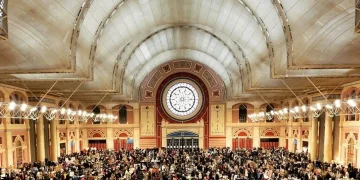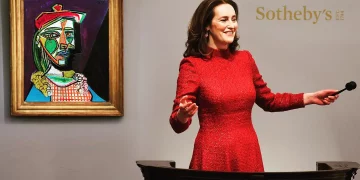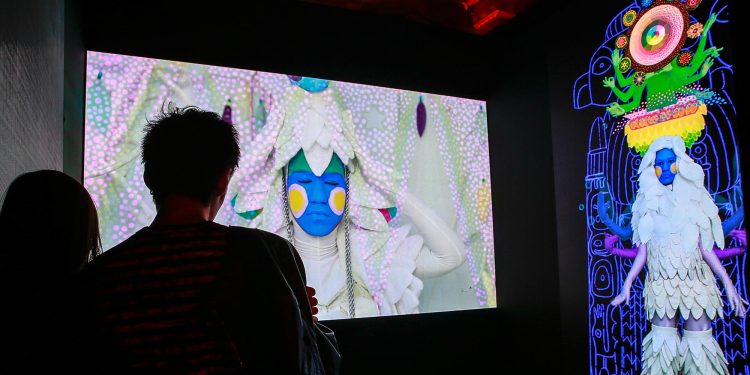In the world of collectibles, art exhibitions and market trends have always been closely intertwined. Every so often, a show or event appears that, upon reflection, seems to have predicted a major shift in the financial world—often before the markets or collectors themselves even realize the implications. One such exhibition, held just before the massive crash of the cryptocurrency market, quietly hinted at the coming downturn, offering valuable insights that collectors, investors, and enthusiasts missed at the time.
The link between art displays and financial movements has been documented throughout history. Often, a cultural or artistic theme arises in sync with economic trends, mirroring the rising or falling fortunes of entire industries. In the case of the crypto crash, the exhibition we’re about to examine provided a series of subtle yet telling signals about the fragility of speculative markets, including the rapid rise of cryptocurrencies, NFTs, and other blockchain-based assets. In hindsight, the clues were all there—yet many in the collecting community, both digital and traditional, failed to see how art could speak so clearly to the coming collapse of an industry many had placed their hopes in.
This article will explore how one art exhibition, in particular, forecast the cryptocurrency crash, examine the cultural signals that were missed by collectors, and highlight the powerful link between art and market trends. Let’s dive into the world of contemporary art, cryptocurrency speculation, and the collective blindness that occurred as a result of overconfidence in the next big thing.
The Rise of Cryptocurrency: Art as a Reflection of the Digital Age
The late 2010s marked the dramatic rise of cryptocurrencies, and their associated technology, blockchain, became synonymous with futuristic innovation. From Bitcoin to Ethereum, the world watched as digital currencies surged in value, creating a new class of billionaires and reshaping the way people thought about money, investment, and ownership. But with the rapid rise of crypto came an equally fast-growing wave of speculative bubbles. The rise of blockchain-based art forms like NFTs (Non-Fungible Tokens) further amplified this trend, attracting a new generation of digital art collectors, who saw digital art as the future of investment.
As these trends began to take hold, the art world reacted in two distinct ways: some artists, galleries, and collectors embraced the wave of crypto-driven art, while others viewed it with skepticism. But one exhibition, held in late 2021, would unknowingly serve as a prophetic look into the collapse of the crypto market—an event that would unfold in early 2022.
This exhibition, “Digital Futures: Art in the Blockchain Era,” was positioned as a celebration of the convergence between contemporary art and the burgeoning world of cryptocurrency. Featuring digital artists who embraced NFTs, augmented reality, and cryptocurrency as their primary mediums, the exhibition boasted a cutting-edge, high-tech experience that attracted the attention of art collectors and cryptocurrency investors alike. On the surface, everything seemed to be aligned with the soaring popularity of blockchain technology, and it was a true cultural moment for the intersection of technology and art.
The Art Themes That Echoed the Crypto Collapse
While the exhibition’s intent was to showcase the futuristic potential of digital art, certain themes and undercurrents present in the works displayed hinted at deeper, more concerning ideas about the fragility of the speculative market that would soon crash. These themes were subtle yet predictive, if not entirely obvious at the time.
One of the most striking features of the exhibition was the presence of works that depicted entropy and decay. Many of the digital artists chose to explore the idea of temporary value through fleeting, disintegrating digital images, mirroring the volatile nature of the markets they were engaging with. Several pieces featured moving images of once-glorious objects or symbols of wealth—such as gold coins, luxurious cars, and towering skyscrapers—slowly disintegrating into binary code or pixelated fragments. The message was clear: everything digital, no matter how valuable it may seem at a given moment, is susceptible to decay and collapse.
One piece in particular, “The Fall of Value” by the artist GlitchWorks, depicted a holographic version of the famous Bitcoin logo being consumed by a digital storm, disintegrating into a pixelated blur. The visual was jarring, invoking a sense of impending doom that was juxtaposed with the euphoric rise of cryptocurrency markets at the time. Yet, to many attendees, it was merely another avant-garde piece, one that spoke to the intersection of digital culture and art. Only after the market crash did people begin to realize that the work was eerily prescient.
Another important theme present in the exhibition was overconsumption. Digital art collectors, particularly in the NFT space, were acquiring art at an unsustainable rate, often without much consideration for long-term value. In one installation titled “NFT Fatigue,” large screens displayed scrolling, repetitive transactions of NFT purchases, accompanied by images of people mindlessly accumulating digital items. The frenetic pace of these transactions was designed to mirror the bubble-like nature of the crypto market, where the rush to acquire assets often overshadowed any real reflection on their intrinsic value.
Though many viewers celebrated the exhibition as a celebration of digital art and innovation, these subtle critiques of excess and impermanence went largely unnoticed until after the crypto market crash. When the dust settled and the value of cryptocurrencies and NFTs plummeted, collectors and investors realized they had been drawn into a speculative frenzy, much like the overconsumption depicted in the art itself.

Collectors Missed the Cultural Signals: Why Didn’t They See It Coming?
So, why did collectors and investors miss the cultural signals embedded in these art pieces? The answer lies in the psychology of speculation and the allure of quick riches. When markets are soaring, the temptation to ignore warning signs is nearly impossible to resist. Just as the tulip mania of the 17th century led to a speculative bubble in the Netherlands, so too did the cryptocurrency boom in the 2020s lead to irrational exuberance. The idea of easy wealth, amplified by social media influencers, celebrities, and tech entrepreneurs, clouded the judgment of many involved in the market.
In the case of the “Digital Futures” exhibition, collectors and crypto enthusiasts were so wrapped up in the possibilities of NFTs and blockchain art that they failed to recognize the subtle messages that warned of instability. The theme of decay, entropy, and the fleeting nature of digital wealth was largely brushed aside as part of the avant-garde appeal of the exhibition, rather than a legitimate commentary on the unsustainable nature of the crypto market.
Moreover, the very fact that the art on display was being sold as NFTs created a sort of self-reinforcing cycle. Buyers believed in the long-term value of digital art because of the perceived value of NFTs themselves, but that value was driven by speculation rather than a genuine cultural or artistic appreciation. In this sense, the exhibition unintentionally played a role in fueling the speculative hype that would eventually lead to a market crash.
The Aftermath: How the Exhibition Became a Post-Crash Reflection
After the collapse of the crypto market in 2022, the “Digital Futures” exhibition took on a new significance. Art collectors and market analysts alike began to look back at the exhibition’s themes, realizing that many of the warning signs were embedded within the artworks themselves. The exhibition, initially seen as a celebration of a new frontier in art and technology, had unwittingly predicted the very collapse of the speculative market it was designed to champion.
In the wake of the crash, many of the artists who had been part of the exhibition saw their NFT sales plummet, with some pieces being sold for fractions of their previous value. The very market that had once celebrated their work was now in turmoil, and the lessons from the exhibition—lessons about excess, impermanence, and overconfidence—were suddenly more relevant than ever.
However, this post-crash reflection did not go unnoticed by the broader art world. Many curators and collectors, who had initially been skeptical of the crypto-art movement, began to view the exhibition as an important cultural artifact that captured the intersection of speculative technology, art, and market psychology. The exhibition, though temporary, had left a lasting impression on the way people think about the intersection of finance and culture.
Conclusion: A Lesson in Cultural Signals and Market Cycles
The “Digital Futures” exhibition stands as a powerful reminder that art, often seen as an aesthetic or emotional experience, can also serve as a cultural barometer. The pieces on display may have seemed to speak only to the digital age’s potential, but upon closer inspection, they offered a clear critique of the speculative nature of emerging markets, including cryptocurrencies. Collectors and investors, blinded by the rush for quick returns, missed these signals, and in doing so, suffered the consequences of a market collapse.
As the world of cryptocurrency continues to evolve, and as new forms of digital art and speculative assets emerge, it is crucial for collectors and investors to look beyond the surface of these trends. The market is ever-changing, but art remains a powerful tool for understanding the forces that drive it. For those willing to listen, exhibitions like “Digital Futures” serve as a valuable reminder of the cultural and financial cycles that shape our world.

















































